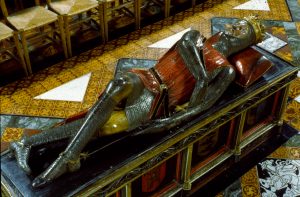 Two medieval tombs at Gloucester Cathedral are of interest to modern visitors of the church and both appear in my novel, Memento Mori, set in 1392 when the cathedral was the church of the Abbey of Saint Peter. These tombs were seen by my heroine, Lady Apollonia, when her party visited the abbey church, as well as by Stedmund Falford, the villain who plays a role in my second and third novels. Though King Edward II was no saint, his tomb had been extremely important in bringing pilgrims’ money to the abbey to pay for the redecoration of the building which occurred in the years just preceding my story.
Two medieval tombs at Gloucester Cathedral are of interest to modern visitors of the church and both appear in my novel, Memento Mori, set in 1392 when the cathedral was the church of the Abbey of Saint Peter. These tombs were seen by my heroine, Lady Apollonia, when her party visited the abbey church, as well as by Stedmund Falford, the villain who plays a role in my second and third novels. Though King Edward II was no saint, his tomb had been extremely important in bringing pilgrims’ money to the abbey to pay for the redecoration of the building which occurred in the years just preceding my story.
Another tomb in Gloucester celebrates the death of Robert, Duke of Normandy, in 1134 at Cardiff Castle. Robert, nicknamed Curthose or short socks because of his stature, was the eldest son of William the Conqueror, inheriting the title of Duke of Normandy on his father’s death in 1087. His brothers outmanoeuvred him for the English throne, and he was imprisoned for the last 28 years of his life. Originally, he was buried in front of the high altar at Gloucester Abbey. A wooden effigy, shown above, was carved in the 13th century and replaced that burial. It was in front of the high altar near the original burial when I first saw it but has now been in the south quire aisle for over two decades. The effigy has been much restored over the centuries including work on it by my friend, Les Jewell, an ecclesiastical wood carver who was based in Exeter.
The death of King Edward II played a minor role in my first novel, Effigy of the Cloven Hoof. My character, the Abbot of Kingswood Abbey, was influenced in his actions by not wanting to repeat the squandered opportunity committed by one of his predecessors in the 13th century who refused to accept the body of King Edward after his death. Kingswood at that time had refused to receive the body of Edward II out of fear of his enemies so he was taken to Gloucester. The abbey not only received the king’s body, after his royal burial, Gloucester’s abbey benefited from the financial gifts of King Edward III, allowing it to make the improvements I mentioned earlier.
The generosity of Edward’s son, King Edward III, helped transform the east of the nave with a new Perpendicular Gothic skin covering the Norman building as I described earlier. One of the deliveries of these royal funds plays a role in the plot of Memento Mori. The tomb of Edward II was carved in the English Decorated Gothic style and the effigy was carved out of alabaster, a new medium for carvers at the time. The royal tombs drew many pilgrims to Gloucester
For more on Robert Curthose, click on
http://professor-moriarty.com/info/section/church-monument-art/13th-century-church-monuments-robert-curthose-duke-normandy-gloucester-c or
https://en.wikipedia.org/wiki/Robert_Curthose
For more on King Edward II, click on
https://en.wikipedia.org/wiki/Edward_II_of_England
Tags: Chaucer's England, historical fiction, medieval mysteries